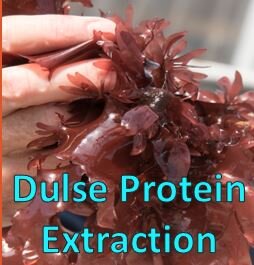
College of Engineering Unit:
As the world population has increased and demand for a sufficient supply of dietary protein has grown, seaweeds have emerged as a sustainable alternative to animal proteins. In particular, red seaweeds have a promising potential to be the leading plant based protein due to their high protein content and rapid growth rates. Traditional crops such as soybeans require significant arable land resources and freshwater irrigation, whereas seaweed can grow in tanks supplied with nutrient-rich tidal seawater. One of the current challenges associated with plant based protein extraction arises from the scalability to an industrial size process. Unlike animal proteins, plants have cell walls that provide increased resistance to disruption techniques. While many methods of protein extraction exist at lab scale for plant cells, they quickly become infeasible due to practical or economic challenges when shifting to pilot scale.
The goal of the project was to evaluate the scalability of primary protein extraction methods for dulse seaweed and select the optimal choice to insert into a pilot-scale process. To accomplish this objective, a comprehensive economic and literature analysis was conducted on protein extraction methods, with particular focus on enzymatic digestion, sonication, bead milling, and the use of freeze-thaw cycles. This required consultations with experts on dulse cultivation, plant protein buyers, and company technicians. The ultimate design of the plant consisted of three major parts. These were pre-treatment of the raw dulse, primary protein extraction, and post-treatment to prepare the protein for sale. A cost analysis on the equipment and raw materials necessary for full plant operation with each primary extraction method was completed to determine a break-even sale price for the dulse protein over the plant lifetime. Because literature on the considered strain of dulse seaweed is currently limited with respect to protein extraction efficiencies, lab-scale research is recommended before attempting to create a pilot scale plant. Once it is determined which extraction methods work best for the dulse, the conclusions of the project may be used to design a real plant.
Project Website(s):
Industry Sponsor(s):
Project Communication Piece(s):
| Attachment | Size |
|---|---|
| 608.08 KB |